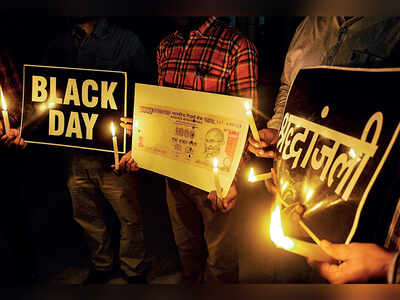By Ajit Ranade
 Disclaimer: The views expressed here are the author's own. The opinions and facts expressed here do not reflect the views of Mirror and Mirror does not assume any responsibility or liability for the same.Two years on, impact of demonetisation is still being debated. Here’s a primer on some key concepts.
Disclaimer: The views expressed here are the author's own. The opinions and facts expressed here do not reflect the views of Mirror and Mirror does not assume any responsibility or liability for the same.Two years on, impact of demonetisation is still being debated. Here’s a primer on some key concepts.
It’s been two years since demonetisation and the debate over its impact on the economy, whether it was good or bad, is still raging. There was a huge upfront cost for the economy (in terms of lower GDP growth, lost jobs, long lines and untold hardships), and there were long-term benefits (more digital transactions, a wider taxpayer base, greater formalisation of the economy).
The government’s demonetisation decision received tremendous support from the public, at least in the initial months. The ruling party was also able to secure electoral advantage in some key state elections. The world at large marvelled at the fact that 86 per cent of the currency was taken out of circulation in a country of a billion people, but there were no street riots. When Venezuela tried to demonetise its largest banknote around the same time, there were riots and the decision was overturned in just a few days.
In India, despite hardship, people supported the decision. This might be because deep down people felt that some “black money hoarders” had been caught by surprise and punished. Is this true? Indeed black money was one of the key reasons the prime minister cited in his historic speech on television on that night of November 8, 2016. Over the course of the next six months, the discourse changed and the objectives of demonetisation kept shifting — from counterfeit currency and terrorist financing to more digital usage, a wider tax net and so on.
But it is worth pondering over the notion of black money. Everyone knows what it is, still it’s worth dispelling some myths. Firstly, what is considered to be black or unaccounted cash is not permanently black. Let’s say you are caught jumping a traffic signal and you pay a bribe of Rs 200 to a cop to wriggle out of the situation. If the cop accepts the note, then your white money becomes black since bribery is illegal. But if he uses that note to pay for a dosa at a restaurant and the waiter hands him a copy of the bill, then black becomes white again. The restaurant owner uses the money for supplies (say potatoes) and the supplier evades taxes. Now, white becomes black. You see the same 200 rupee note changes sides.
Secondly, there is a difference between illicit money accumulated through tax evasion and criminal activities such as selling drugs. The former is “compoundable”, meaning you can pay afine and remove the illegality of the black money. But drugs money cannot become legal. You can’t simply pay a fine, you go to jail.
Thirdly, the estimate of black money (excluding that created through sale of drugs or illegal firearms) is around 20 to 25 per cent of the national income. Please note that this depends on the taxation level — as tax rates go down, so does the incentive to hide income from taxes. This reduces the stock and flow of black money. When “tax terrorism” (a phrase used by the BJP in its 2014 manifesto) increases, then levels of black money are also likely to go up.
Fourthly, there is also a difference between stock and flow of black money. The former is accumulated over decades, or generations. The latter is the result of an illegal transaction to evade tax or a traffic fine. The ‘stock’ is kept mostly in non-cash form as gold, benaami property (land and flats), overseas assets. Only 7 per cent of the stock of illegitimate wealth is kept in the form of cash. This has been confirmed by the government’s own data of raids on tax evaders. Hence the idea of using demonetisation to attack illegitimate and unaccounted wealth was misguided. Of course, discontinuing high-value notes still makes sense since they are often used more for illegal activities, including money laundering.
The fifth key fact is that even though black money transactions occur everywhere, only three sectors probably account for the bulk of its generation — election funding, real estate and education. A senior politician in Mumbai once famously said that he spent Rs 8 crore on his election campaign even though the official limit was only Rs 40 lakh. This means that 95 per cent of his expenditure was black money (by definition). Thus if we want to make a decisive impact on the generation of black money, we need to make campaign financing transparent and introduce reforms in real estate and education sectors. The tax rates should also be lowered.
Lastly, not everyone who deals in only cash is a black money operator. The “cost” of switching to digital is significant. For instance, you need to have a bank account and good internet connectivity, and you should be able to afford the “commission” charged by card service providers. Many small and micro businesses have a competitive advantage in dealing only in cash. Think of a farmer or a grocer in a remote taluka.
No comments:
Post a Comment